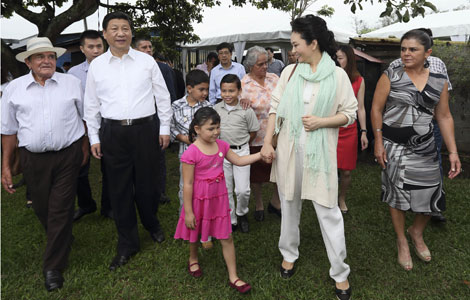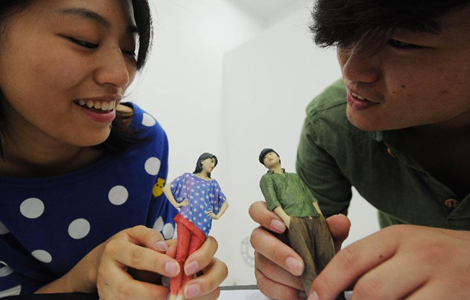Drivers with great potential
Updated: 2013-04-03 07:15
By Zhao Xiao and Teng Qizun (China Daily)
|
||||||||
Domestic consumption, the vitality of innovation and the dividends of further reforms will boost next-stage growth
A recent slowdown in the troika of China's economy export, investment and consumption has highlighted the need for the world's economic powerhouse to find new sources of sustainable growth to facilitate its bid to build a well-off society in an all-round way and realize its long-cherished dream of national rejuvenation.
According to the National Bureau of Statistics, the country's final consumption declined to 51.8 percent of its gross domestic product in 2012, down from 62 percent in the 1980s, and its household consumption declined to 49.1 percent in 2011, from 65.6 percent in 1980. Aside from high investment and deposit ratios and the high government spending that have squeezed household consumption, the country's ever-widening income gap and the weak pro-consumption policies have also contributed a great deal to its consumption insufficiency.
Despite a series of measures adopted to stimulate domestic consumption since 2007, China has yet to boost the role of consumption in national economic growth. In fact, the desire to spend has even declined. All these mean it will be difficult to use consumption to stabilize national economic growth in the years ahead.
Alongside the weak consumption are the gloomy prospects for the country's exports. China has set its foreign trade growth at 8 percent for 2013, a single-digital growth that has been in sharp contrast with a double-digital pace it has witnessed for many years. This is a reflection that the mainland has changed its foreign trade approach from the quantity-focused to quality-focused. The lower target also means China cannot repeat its past model of depending on a foreign trade boom for national economic growth.
Statistics released by China's customs indicate that its trade surplus was $183.21 billion yuan ($29.50 billion) in January, an increase of 7.7 percent from a year earlier and its import and export volume grew 8.1 percent year-on-year. However, this was still a 5.8 percent decline on the volume last December.
The investment environment China faces is also not optimistic. Despite its rapid development over the past decades, the country still cannot completely wean its economic development off investment expansion, although such efforts have been made. Several rounds of huge investment in recent years and the economic fluctuations have prompted the Beijing authorities to turn to a wide range of macroeconomic policies to put a brake on investment enthusiasm, as indicated by the adoption of harshest-ever regulatory measures on the domestic housing market and tightened investment credit policies. Such efforts to restrain investment have had an enormous impact on the real estate sector and manufacturing.
Data indicate that the country's investment in the construction sector, which is closely related to real estate, decreased 39 percent year-on-year in January and February. The country's purchasing managers' index, a gauge of manufacturing trends, also declined to a pessimistic five-month low of 50.1 percent in February before picking up to 50.9 in March. All these mean it will be increasingly difficult for China to maintain the high-paced investment momentum of previous years.
The lukewarm economic outlook highlights the necessity for China to explore new areas of sustainable economic growth as a way to build a well-off society and fulfill the long-cherished dream of rejuvenation.
At his first news conference after he was elected premier in mid-March, Li Keqiang said his government is committed to promoting sustainable growth as a top priority and will seek to convert the dividends to be brought by reforms, domestic demand potential and innovation into the driving forces of national economic transformation.
To enjoy more reform-induced dividends, the country should push for institutional reforms and improvements to effectively reduce transaction costs and boost economic development. According to experts, reforms have contributed 45 percent to 48 percent of China's economic growth over the past decades. Once institutional fetters that hamper national economic development are removed, China's economy will come to a new development stage.
The profound changes in internal and external economic circumstances and lingering external economic uncertainties have made it more urgent than ever for China to advance reforms in some areas. The election of reform-minded leaders at the 18th National Congress of the Party in November means the time is now ripe for China to draft a timetable for systematic and deeper reforms in some key areas.
International practices indicate that a country's household consumption ratio is usually no lower than 61.7 percent once the per capita GDP reaches $1,000. Despite a per capita GDP of $5,532 in 2011, China's household consumption ratio was only 49.1 percent, which means it still has a lot of room for improvement. As the country's pro-consumption policies further unfold and it accelerates urbanization, domestic demand will be further boosted and become a major source of national economic growth.
If the country's innovation capability can be further elevated, this will be another driving force for China's sustainable economic development in the years ahead. According to a recent report issued by the Geneva-headquartered World Intellectual Property Organization, China has become one of the world's leading patent holders although some of them fail to reach the highest level. The ever-increasing number of patents is a reflection of the growing importance China's enterprises have attached to improving the technology of their products, promoting technological innovations and pursuing a domestic-driven growth model.
Zhao Xiao is a professor with the School of Economics and Management, Beijing University of Science and Technology, and Teng Qizun is a member of the university's research section on China's Economy.
(China Daily 04/03/2013 page8)
Most Viewed
Editor's Picks

|

|

|

|

|

|
Today's Top News
Relationship 'relaunched'
Good start expected for summit
Xi, Mexican president discuss bilateral co-op
Cooperation to drive mutual growth
Chinese president arrives in Mexico for state visit
China is victim of hacking attacks
US to be largest trade partner
China joins fight against hacking
US Weekly

|

|















